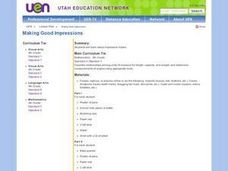Curated OER
Weather Tools
Students explore Earth science by participating in a weather identification activity. For this scientific instrument lesson, students identify several weather related tools such as the weather vane, thermometer and rain gauge. Students...
Curated OER
Mud Splat Craters
Students simulate crater formation using mud. In this earth science instructional activity, students identify the features of a crater. They explain how the force of impact affect the crater's appearance.
Curated OER
What Are Mixtures And Solutions?
Students explore mixtures and solutions. For this chemistry lesson plan, students will add different ingredients to jars in order to classify them as mixtures or solutions. There is also a nail balancing activity that can be done at home.
Curated OER
Plotting the Petroleum Plume
Eighth graders examine the difference between confining layers and aquifers in a basic water table aquifer scenario. They contour groundwater elevation and petroleum product thickness data.
Curated OER
Math: Counting on Others
Learners use counting skills to decide who wins the Classroom Winter Games. They use numeral writing and tally marks to keep score. Students have an opportunity to pretend they are competing for medals in the Winter Games while using...
Curated OER
Mountain Building
Fourth graders identify variables that influence rates of change. They, through group consensus and using the assigned materials, design and build what they believe to be the strongest mountain possible.
Curated OER
What's The Level?
Pupils examine the movement of the water table and saturation zones. They describe the movements of the water table and locate the saturation zones. Students identify the function of each saturation zone. They develop a model of the...
Curated OER
Go With the Flow
Students experiment with a simulated river bed and examine how erosion takes place faster with a young, fast-moving river than with a slow, older river.
Curated OER
Turn On A Light And Do Your Own Revegetation
Students use electricity and plant a seed to observe the process when coal is the major fuel source to produce electricity. They use the packet of native seeds to experiment with revegetation.
Curated OER
Habitat Unit - Day 2
Learners explore abiotic factors that affect habitats. After a class lecture, students work in groups to answer questions about plant tissue, production and growth. They share answers, complete a crossword puzzle, and create a habitat...
Curated OER
ASWAN HIGH DAM
Students use modeling compound, Lego blocks, water, paper and tape to construct and label the Aswan High Dam.
Curated OER
Materials Engineering: Designing Walls
Students discover how the matierals in the earth can be used to make walls and buildings. They examine the Great Wall of China and its engineering. They complete the unit by creating their own wall from a design they drew.
Curated OER
Exploring For Copper Deposits
Young scholars examine ore deposits and identify factors in their origin. They analyze geologic maps, and locate porphyry copper deposits on a sediment geochemistry map.
Curated OER
Life in a Cup
Third graders make and maintain a mini terrarium. They keep a daily journal of what happens in their terrarium and record daily observations and measurements.
Curated OER
Limestone
In this limestone worksheet, students name three sources of calcium carbonate, write the chemical formula, and determine the three elements found in calcium carbonate. This worksheet has 7 short answer and 3 problems to solve.
Curated OER
Making Good Impressions
Fourth graders participate in an experiment where they experiment with impression fossils. They identify and describe the measurable attributes of the impression fossils. There are many parts and materials for this experiment.
Curated OER
Using Land
For this land usage worksheet, students read about farmers in Bolivia are using a system called raised-bed agriculture to feed its people. Students complete 2 short answer questions based on what they read.
Curated OER
Antarctica Vocabulary Quiz
In this Antarctica vocabulary worksheet, learners match vocabulary words about Antarctica with definitions, 15 words total. Worksheet contains a link to additional activities. Labeled as a quiz, but may be used for practice or review.
Curated OER
Leave What You Find
Students explore environmental awareness by participating in a role play activity. In this cultural analysis lesson, students discuss the importance of symbolism when referring to a tribe and create their own tribe based on a small group...
Curated OER
Cleansing, Sparkling Koos
Students explore the importance of water conservation and investigate how plants clean water.
Curated OER
Frozen Film
Students are introduced to the topic of light interference through this hands-on activity. They observe how light reflects off two surfaces and then meets to form an interesting variation of color on a film surface.
Curated OER
Dino Detectives
As students examine maps of Utah, 4th graders search for clues about what prehistoric life was like in Utah.
Curated OER
The Mystery of the Sponge
First graders observe while water is absorbed into a sponge. They experiment by putting a sponge on yardstick and watch while water dries and the weight changes.
Other popular searches
- Minerals Rocks Soils
- Science Rocks and Soils
- Rocks and Soils Ks2
- Primary Rocks and Soils
- Rocks and Soils Ks21

























